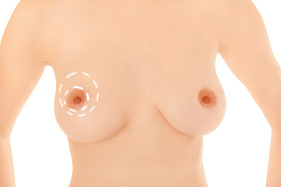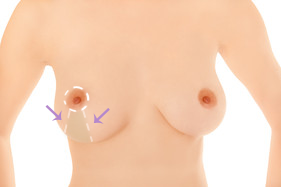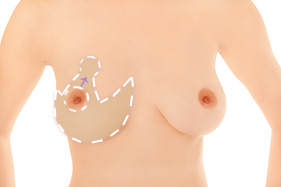Breast reduction involve removing excess fat, glandular tissue and skin to obtain breast size proportional to the body shape.
Too large breasts can cause both health and emotional problems. Weight of excess body fat may hinder active lifestyle, and an emotional discomfort, that often accompany women with big breasts is as important issue for them, as pain and the physical discomfort. Disadvantages of having large breasts:
- Spine overloading can be responsible for damage in skeletal system, difficulty in breathing, and interfere with normal physical activity.
- Attract unwanted attention from other people, which can be embarrassing.
- Distort the proportions of the figure, making it look massive and heavier than in reality.
- Cause pain in the chest, neck or back.
Performance of breast reduction is often the best way to eliminate all the psycho-physical ailments. Failure to do so often leads to the health problems that cannot be reversed.
Preparing for surgery
Do the necessary tests prescribed by the doctor in the process of qualification Follow your doctor’s instructions about medications that you should take prior to surgery Quit or at least limit smoking 2-4 weeks prior to surgery Two weeks before surgery do not take aspirin, its derivatives and any herbal supplements that affect blood clotting (blood thinners)
Operation
Breast reduction surgery is usually done by making an incision on the skin of the breast, designed to cut excess skin, fat and gland. In some cases fat can be removed by liposuction combined with the removal of skin. In cases where the problem is only in excessive fat – satisfactory result can be achieved just by the liposuction alone. The surgical technique is selected during a personal consultation with plastic surgeon and is dependent on patient breast shape and individual expectations. Regardless of the surgical technique, breast reduction is always performed under general anesthesia.
Possible types of surgical cuts:
1.Round, around the areola;

2.Incision in the shape of a key (the shape of tennis racket). Round incision around the areola and vertical incision from areola to the breast fold;

3.Incision in the shape of an inverted T („anchor”) – around the areola, vertical from areola to a furrows between the breast and horizontal along the furrows under the breast.

After the surgical cut, nipple areola is moved into new location. If necessary, it is then also reduced. Breast tissue is reduced, breast lifted, gaining a new nice shape. Typically areola complex is not separated from its original innervation and blood supply. Moving the whole nipple is rare, recommended only when dealing with giant breast. The procedure typically takes from 2 to 4 hours. However, to fully enjoy the results you have to wait at least few weeks, sometimes months. Swelling subside in different individuals with different speed, sometimes unsymmetrical.
Operation, risk and possible complications
The decision to undergo surgery is a personal matter. Patient must itself determine whether the surgery outcome will meet her expectations and if she is willing to accept the risk and potential complications. The risk includes:
- overgrowth scars
- infections
- poor wound healing
- the risks associated with anesthesia
- excessive bleeding
- changes in nipple and breast sensitivity, which usually are just a temporary ailments, in some cases may become permanent
- Changes in skin pigmentation
- swelling
- irregularity of the breast contour
- breast asymmetry
- hematoma
- inability to breast-feeding
- low risk of skin necrosis on the border between the vertical and horizontal cuts,
- probability of re-operation.
NOTE! Despite expectations of good results of surgery, there is no guarantee. In some situations, it may be impossible to achieve the best results by doing just one treatment. Sometimes another, a small adjustment may be required in order to achieve the desired aesthetic goal.
Post-operative procedures
Each patient receives a special, well-fitting bra to wear continuously for 6 weeks. In the first four weeks, it is recommended to pay special attention to the reactions of the body. Avoid lifting and perform rapid, vigorous movements even if you do not experience pain or other symptoms of a recent operation. Rest is recommended to allow for fast healing. Sporting activities, housework (ironing, washing windows), intense pectoral muscles, or sleeping on the stomach at this time are excluded. You should also avoid excessive sun exposure, solarium and sauna. For the first three months after the wounds heal patient should perform massage of operated area and use scar reducing ointments or creams. According to the surgeon recommendations you should remove the stitches 10-14 days after surgery. This can be done at the any outpatients clinic or doctor’s office chosen by your family practitioner. At the time of discharge from the clinic each patient receives detailed information about further care.
Post Operative Recommendation
- During the first two weeks after surgery you should take Vitamin C; 3 x 1 tablet
- Every second day change the dressing and clean the wound with salicylic spirit (alcohol) or perhydrol liquid and put the antibiotic ointment Betadine or Nitrofurazon
- It is advised to change the dressing in sterile dispensary
- 3 weeks after surgery scarfs should be greased with Dermatix ointment (twice a day)
- During 8 weeks after surgery you have to wear the bra day and night
- For 3 weeks from your surgery every (even simple) activity, that requires physical efford like: cleaning, vaccuming or washing is forbidden
- During the first 6 weeks you cannot do any exercises, e.g aerobic, fitness, swimming, etc.
- During the first 3 months: sun-bathing, solarium and sauna are forbidden Patient received a prescribtion for / Patient was given medication from Clinic:
- Painkiller medication: Ketonal (in case of pain)
- Ointment with antibiotic: BETADINE or NITROFURAZON
If you have any doubts you should immediately contact with the Clinic
Hereby we wish to inform that each patient is treated individually. The cases differ between each other, therefore this instructions may be somehow different than those that you will receive from your surgeon after the operation.









